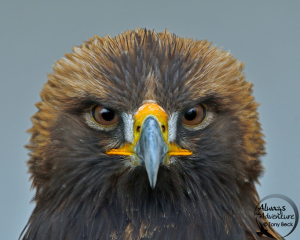
Golden Eagle (captive) – Southern Ontario
Nikon D500 with AF-S Nikkor 200-500 F5.6 VR zoom ~ ISO 400 – Shutter 1/500 – Aperture F6.3
Eagles have the best vision of any animal alive today. Golden Eagles can spot small prey from more than a mile away. Some eagles have sight that’s eight times as good as humans. With binoculars, you’ll have eyes of an eagle.
Like many comic book and action hero fans, I fantasize about having superpowers. Sadly, I’m just a normal human just like everyone else. But, you don’t have to be born with superpowers. Like Batman and Ironman, anyone can accomplish incredible feats with a few fancy accessories. Imagine having super eyesight like an Eagle. I’m sure we’d all love to enhance our vision by seven or eight times. Well, It’s easy with a pair of quality binoculars.
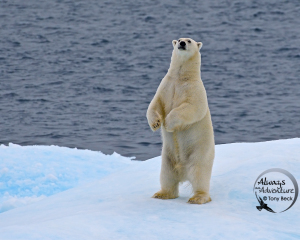
Polar Bear – Nunavut, Arctic Canada
Nikon D7500 with AF-S Nikkor 200-500 F5.6 VR zoom ~ ISO 400 – Shutter 1/1000 – Aperture F7.1
Polar Bears typically hunt for prey while riding on sea ice. When sailing through the Northwest Passage, I use binoculars to find these enigmatic marine mammals. Once they’re spotted, often at extreme distances, our vessel can move into position for good photo opportunities.
The best nature and wildlife photographers have a knack for finding wildlife. In the field, it helps to have heightened awareness, especially for locating shy and elusive animals like furtive mammals, cryptic reptiles or small songbirds. Although all our senses should be involved in the search, a good pair of binoculars greatly improves our vision making it much easier to spot potential photographic subjects, especially at a distance.
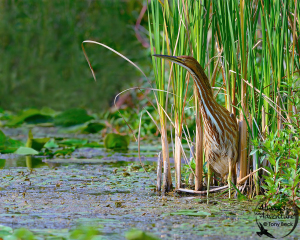
American Bittern – Eastern Ontario
Nikon D4 with AF-S Nikkor 300 F4 with TC14E11 ~ ISO 800 – Shutter 1/1250 – Aperture F8
Like this American Bittern in a Cattail Marsh, many animals blend into their environment making them difficult to see, even at close range. With good binoculars, you’ll see more contrast and detail than if you’re looking through a camera’s viewfinder. Once you spot your subject, you’ll know where to point your camera.
So, why do some wildlife photographers avoid them? For some, their justification is that binoculars are unnecessary. Why would they carry extra equipment if all they need is their telephoto lens to see things bigger?
Although looking through a camera’s viewfinder attached to a telephoto lens does provide magnification, the view hardly compares to good binoculars. Binocular optics are designed to provide clarity with a wider field of view compared to a telephoto lens of equivalent magnification. Combine that with features like compact size, lightweight and quality performance under varying conditions and you’ve got a tool that I feel is essential for productive wildlife photography. By improving awareness, binoculars help photographers find targets they want to photograph. They significantly increase photographic opportunities in ways a camera alone can’t. Without them, there’s potential to miss important details, especially at a distance or in dense habitats. With them, anyone can be more efficient and effective.
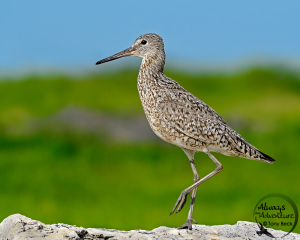
Western Willet – Southern Manitoba
Nikon D500 with AF-S Nikkor 200-500 F5.6 VR zoom ~ ISO 400 – Shutter 1/1250 – Aperture F8
Many species look similar to others, especially at a distance. When searching for something rare or unusual, it’s difficult to study details without a proper view. Telling this Western Willet from other more common species requires noticing subtle characters like bill thickness and leg colour. Good binoculars can make the difference between chasing common species and more desirable targets.
My objective in the field is to find animals well before getting close to them. My awareness depends on all my senses including hearing, and even smell. However, sight is by far the most important. During a field session, I typically scan the horizons looking for anything of interest. When I identify a potential target, I’ll evaluate the situation and plan a strategic approach. If conditions warrant, I might be able to get close for a frame-filling shot. Binoculars help me through this entire process.

American Marten – Algonquin Park, Ontario
Nikon Z7 with AF-S Nikkor 500mm F5.6 PF ED VR ~ ISO 400 – Shutter 1/1000 – Aperture F8
Small mammals can all look similar. This American Marten can easily be confused with the more common Red Squirrels or Mink, especially at a distance. Better than your telephoto lens, binoculars help you sort through the subtle colour and shape differences that allow you to be more efficient in the field.
Selecting the right binocular is often a personal choice. There are many types to choose from. Models are identified by two sets of numbers separated by an X (times symbol). The first number is the magnification. The second is the diameter of the objective lens (the lens at the end of each binocular barrel that’s furthest from the eyes when you’re looking through them). This is measured in millimeters. For example, a popular model might be 8 X 42. This means the binocular magnifies eight times and the objective lens is 42 millimeters wide.
Like telephoto lenses, the more magnification the more difficult it is to keep the image stable. The wider the objective lens the more light-gathering ability. Often, wide objective lenses offer wider fields of view. Price often depends on the quality of construction, especially regarding glass, prisms, and coatings. The highest quality typically uses the best glass with coatings on all their surfaces.

Adelie Penguin – Antarctic Peninsula
Nikon D7200 with AF-S Nikkor 200-500 F5.6 VR zoom ~ ISO 200 – Shutter 1/1000 – Aperture F9
Wildlife Photographers often work under adverse conditions. You can expect your binoculars to work under any conditions if they’re waterproof and rugged. Even when there’s blowing ice pellets and frigid temperatures, I’ll still have my binocular out looking for opportunities.
For the brightest and clearest views, the best binoculars are usually big, heavy and expensive. These are perfect for activities like sailing or stargazing. However, if you’re hiking with multiple pieces of camera equipment, or if you’re out for extended periods of time, big binoculars might slow you down, interfere with your momentum and become a burden. For photographers, I’d recommend keeping it simple. Some of the best models that compliment photographic fieldwork are in the range of 8 X 30. Although these smaller (compact) models might not perform as well as larger ones under extreme conditions like low light at dawn or dusk, they can still provide a view that’s sharp, clear, bright and accurate. For certain, they always reveal far more details than any camera’s viewfinder. Their small size and lightweight make them comfortable, easy-to-use and unlikely to interfere with your photography. If you’re in the field a lot, look for models that are durable, waterproof and come with an extended warranty.
As a bonus, modern compact binoculars work well for all sorts of activities. They’re ideal for any outdoor endeavor like hiking, birding, camping, or anything that requires you to minimize your load while you’re enjoying the great outdoors.
When you buy binoculars, read the owner’s manual. Before using them, follow the instructions provided by the manufacturer. This includes an exercise that calibrates the binocular to provide maximum performance with the user’s personal vision.
If you want to be a more effective wildlife photographer, do yourself a favour and invest in a pair of high-quality compact binoculars.
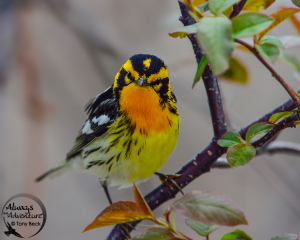
Blackburnian Warbler – Point Pelee National Park, Ontario
Nikon D7200 with AF-S Nikkor 300 PF ED VR ~ ISO 400 – Shutter 1/1000 – Aperture F5.6
I rely on all my senses to find wildlife. However, even at close range I frequently need binoculars to identify my targets, especially in thick vegetation. Although I can discern the distinctive calls of small secretive birds like this Blackburnian Warbler, I need the efficiency of my binoculars to help me sort through other more common or less attractive species before knowing where to point my camera.



